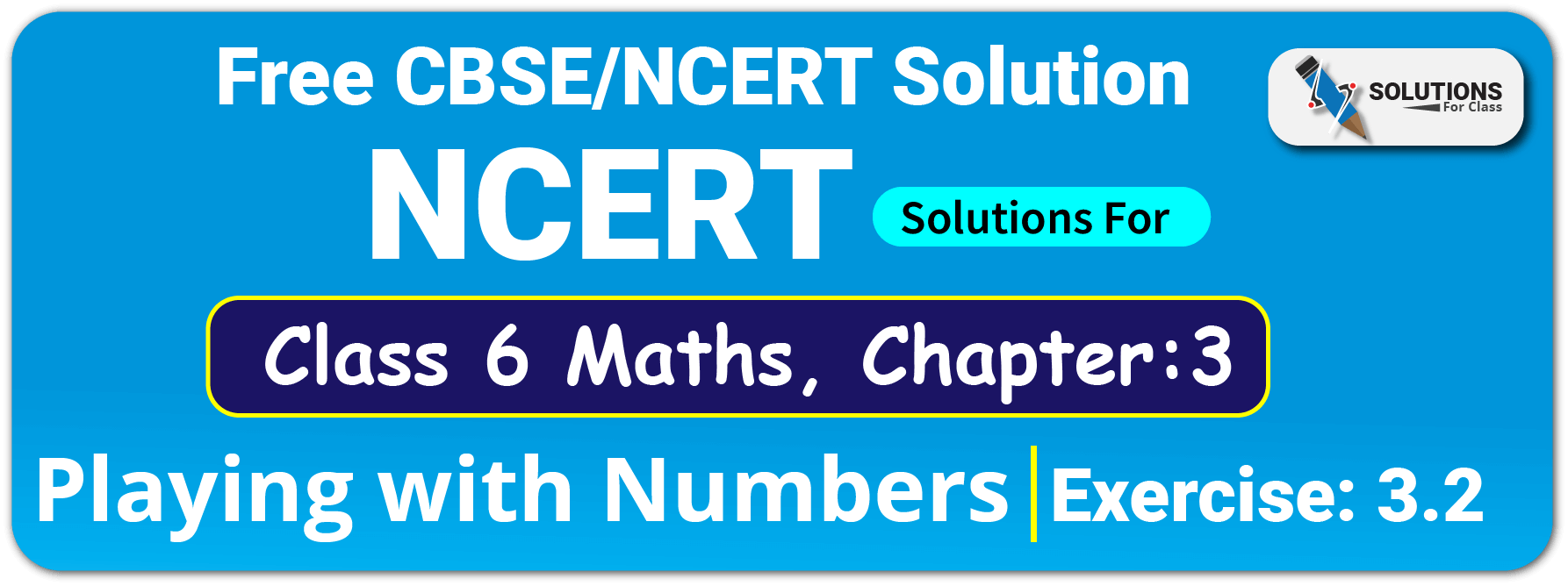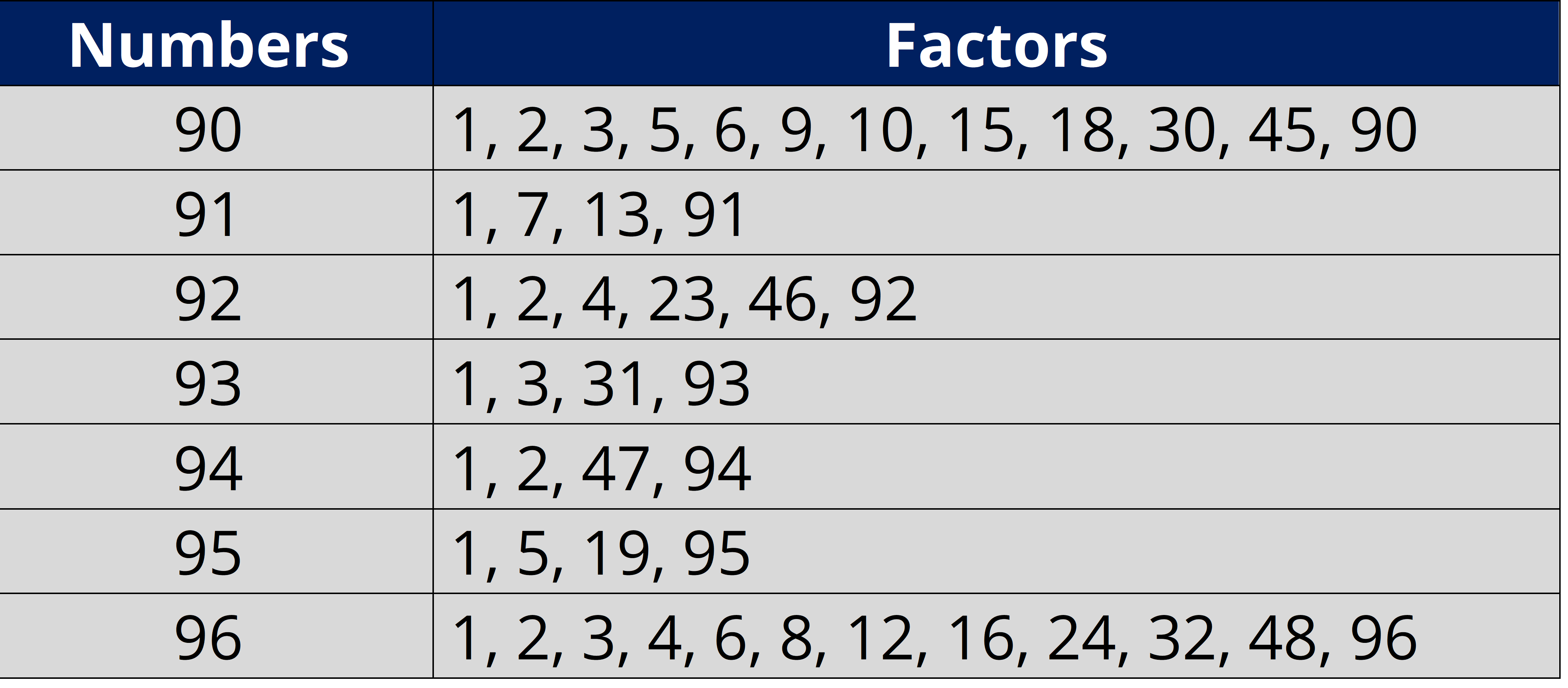
Table of Contents
ToggleClass 6, Maths, Chapter 3, Exercise 3.2 Solutions
Q.1. What is the sum of any two (a) Odd numbers? (b) Even numbers?
Ans:
(i) Odd number = Number that cannot be divided by 2.
(ii) Even number = Number that can be divided by 2.
(a) The sum of any two odd numbers is even numbers.
Examples:
3 + 5 = 8,
7 + 3 =10,
15 + 17 = 32
(b) The sum of any two even numbers is even numbers
Examples:
4 + 8 = 12,
8 + 6 = 14,
16 + 16 = 32
Q.2. State whether the following statements are True or False:
(a) The sum of three odd numbers is even.
(b) The sum of two odd numbers and one even number is even.
(c) The product of three odd numbers is odd.
(d) If an even number is divided by 2, the quotient is always odd.
(e) All prime numbers are odd.
(f) Prime numbers do not have any factors.
(g) Sum of two prime numbers is always even.
(h) 2 is the only even prime number.
(i) All even numbers are composite numbers.
(j) The product of two even numbers is always even.
Ans:
(a) False, The sum of three odd numbers is odd.
Explanation: 3 + 5 + 7 = 15 i.e. odd number
(b) True, the sum of two odd numbers and one even numbers is even.
Explanation: 3 + 5 + 8 = 16 i.e., even number.
(c) True, the product of three odd numbers is odd.
Explanation: 3 × 5 × 7 = 105 i.e., odd number.
(d) False, if an even number is divided by 2, the quotient is even.
Explanation: 8 ÷ 2 = 4 i.e., even number.
(e) False, all prime numbers are not odd.
Explanation: 2 is a prime number but it is also an even number.
(f) False, Prime numbers do have factors like 1 and the numbers itself are the factors of the numbers.
(g) False, Sum of two prime numbers may also be odd number
Explanation: 2 + 3 = 5 i.e., odd number.
(h) True, 2 is the only even prime number.
(i) False, 2 is the prime number.
(j) True. The product of two even numbers is always even.
Explanation: 2 × 4 = 8 i.e., even number.
Q.3. The numbers 13 and 31 are prime numbers. Both these numbers have same digits 1 and 3. Find such pairs of prime numbers upto 100.
Ans: Let’s know what is the prime number:
A prime number is a number that is only divisible by 1 and by the number itself.
The prime numbers with same digits upto 100 are:
17 and 71
37 and 73
79 and 97
Q.4. Write down separately the prime and composite numbers less than 20.
Ans:
Prime number: A prime number is a number that is only divisible by 1 and by the number itself.
In other words, Prime numbers are the numbers that has only two factors: 1 and number itself
Composite number: A composite number has more than two factors. For example, 4 is a composite number because it can be factored as 2 x 2.
Remember: Every Number that is not a prime number is a composite number.
(a) Prime numbers: 2, 3, 5, 7, 11, 13, 17 and 19 are the prime numbers less than 20
(b) Composite numbers: 4, 6, 8, 9, 10, 12, 14, 15, 16 and 18 are the composite numbers less than 20.
Q.5. What is the greatest prime number between 1 and 10?
Ans:
The greatest prime number between 1 and 10 is 7.
The prime numbers between 1 and 10 are: 2, 3, 5, 7. Out of these, 7 is the greatest prime number.
Q.6. Express the following as the sum of two odd primes.
(a) 44
(b) 36
(c) 24
(d) 18
Ans:
(a) 3 + 41 = 44
(b) 5 + 31 = 36
(c) 7 + 17 = 24
(d) 3 + 15 = 18
Q.7. Give three pairs of prime numbers whose difference is 2.
[Note: Two prime numbers whose difference is 2 are called twin primes].
Ans:
The three pairs of prime numbers whose difference is 2 are
(3, 5): The difference between 3 and 5 is 2.
(5, 7): The difference between 5 and 7 is 2.
(11, 13): The difference between 11 and 13 is 2.
Q.8. Which of the following numbers are prime?
(a) 23
(b) 51
(c) 37
(d) 26
Ans:
(a) 23 and (c) 37
Explanation:
(a) 23
1 × 23 = 23
23 × 1 = 23
∴ 23 has only two factors 1 and 23. Hence, it is a prime number.
(c) 37
1 × 37 = 37
37 × 1 = 37
∴ 37 has two factors 1 and 37. Hence, it is a prime number.
Q.9. Write seven consecutive composite numbers less than 100 so that there is no prime number between them.
Ans:
Seven composite numbers between 89 and 97 both which are prime numbers are 90, 91, 92, 93, 94, 95 and 96.

Q.10. Express each of the following numbers as the sum of three odd primes:
(a) 21
(b) 31
(c) 53
(d) 61
Ans:
(a) 3 + 7 + 11 = 21
(b) 5 + 7 + 19 = 31
(c) 13 + 17 + 23= 53
(d) 13 + 17 + 31 = 61
Q.11. Write five pairs of prime numbers less than 20 whose sum is divisible by 5.
(Hint: 3 +7 = 10)
Ans:
The five pairs of prime numbers less than 20 whose sum is divisible by 5 are
2 + 3 = 5
5 + 5 = 10
2 + 13 = 15
3 + 17 = 20
7 + 13 = 20
Q.12. Fill in the blanks:
(a) A number which has only two factors is called a ______.
(b) A number which has more than two factors is called a ______.
(c) 1 is neither ______ nor ______.
(d) The smallest prime number is ______.
(e) The smallest composite number is _____.
(f) The smallest even number is ______.
Ans:
(a) A number which has only two factors is called a prime number.
(b) A number which has more than two factors is called a composite number.
(c) 1 is neither prime number nor composite number.
(d) The smallest prime number is 2.
(e) The smallest composite number is 4.
(f) The smallest even number is 2.
NCERT Solutions For Class 6 Maths, Chapter 3 Playing With Numbers (All Exercises)
Class 6, Maths, Chapter 3, Playing With Numbers
Class 6, Maths, Chapter 3, Playing With Numbers, Exercise 3.1
Class 6, Maths, Chapter 3, Playing With Numbers, Exercise 3.2 ← You are here
Class 6, Maths, Chapter 3, Playing With Numbers, Exercise 3.3
Class 6, Maths, Chapter 3, Playing With Numbers, Exercise 3.4
Class 6, Maths, Chapter 3, Playing With Numbers, Exercise 3.5
Class 6, Maths, Chapter 3, Playing With Numbers, Exercise 3.6
Class 6, Maths, Chapter 3, Playing With Numbers, Exercise 3.7

